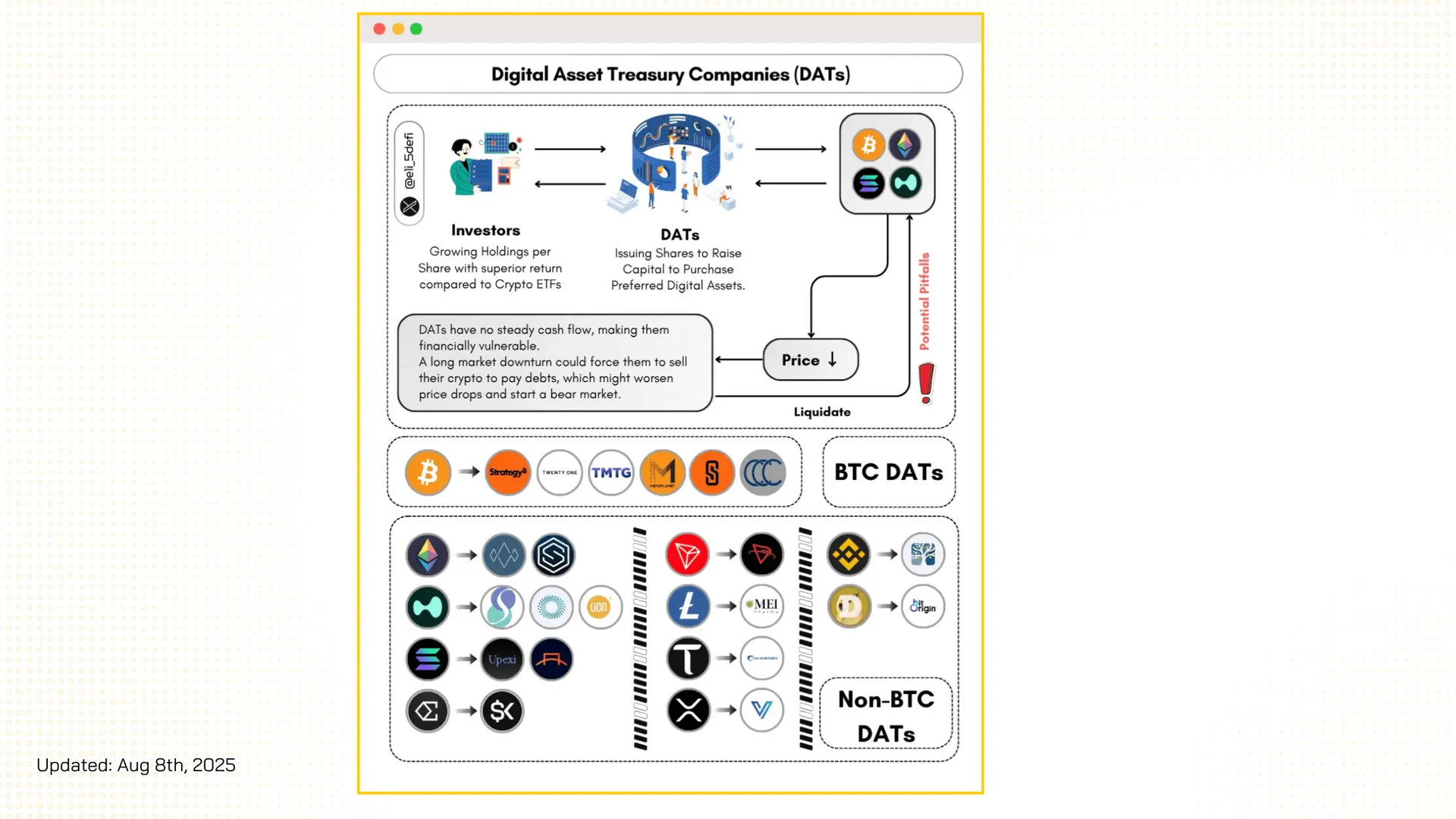The concept of Digital Asset Treasuries (DATs) is still relatively new in the crypto world, but in a constantly changing market, DATs could be a crucial link shaping the future.
What are Digital Asset Treasuries (DATs)?
DATs is an acronym for Digital Asset Treasuries, a model that refers to publicly listed companies that hold cryptocurrencies such as Bitcoin, ETH, or other crypto assets as part of their financial strategy. Unlike ETFs that passively reflect market price fluctuations, this model focuses on actively accumulating digital assets for shareholders through proactive capital management strategies.
How DATs Operate
DATs businesses typically begin by raising capital through the issuance of new stocks or bonds (including zero-interest bonds). However, instead of using this capital to expand business operations—like investing in factories, product research, or market expansion—they directly convert it to crypto and record these assets on their balance sheets under the category of "indefinite-lived intangible assets" according to GAAP accounting standards.

This means that the crypto assets are not subject to periodic amortization, but when the market price drops below the purchase price, the company must record an impairment loss. This loss cannot be reversed if the price increases again unless the assets are sold.
The DATs Operating Model
Once crypto assets are on the balance sheet, each share of the company's stock becomes an indirect proxy for ownership of that crypto. Investors do not need to manage cold wallets or private keys but can still gain exposure to the crypto market by holding the company's stock—an indirect form of "tokenizing" crypto into a public security. This approach is friendly to institutional or traditional investors, especially given the legal and technical barriers that make it difficult for them to directly engage with digital assets.
The DATs model is therefore seen as an intersection between traditional finance and crypto assets. DATs allow companies to leverage the capitalization power of the stock market to accumulate digital assets on a large scale, while offering shareholders a transparent and auditable crypto investment tool that is subject to strict financial oversight.
Two Common Approaches for DATs
Companies operating under the DATs model do not always follow the same strategy. In fact, they can be categorized into two main trends based on their financial goals and how they position crypto assets within their corporate strategy.
Risk Mitigation Tool
Some businesses view crypto assets, particularly Bitcoin, as a hedge against inflation or economic instability. A prime example is Tesla, which invested $1.5 billion in Bitcoin as part of a strategy to diversify assets and preserve the value of its cash reserves. However, this approach is typically cautious, with crypto accounting for only a small portion of the company's total assets. In this case, crypto acts as "digital gold"—a defensive tool rather than a growth asset.
Strategic Investment Focus
Other companies take a more aggressive approach, positioning Bitcoin and other digital assets as the cornerstone of their treasury strategy. In this case, crypto is no longer an auxiliary investment but becomes a primary asset, with the goals of:
- Increasing shareholder value through the expected appreciation of digital assets.
- Building a financial foundation based on decentralized assets.
- Positioning the brand as a modern company aligned with the crypto community.
MicroStrategy is a classic example of this group. Since 2020, the company has continuously raised capital (via stock issuance or convertible bonds) to purchase large quantities of Bitcoin. By the end of July 2025, MicroStrategy owned over 628,000 BTC, valued at nearly $46.8 billion, with an average purchase price of approximately $73,227/BTC. Each share of the company's stock is now viewed as an indirect proxy for a portion of Bitcoin ownership.
The Rise of the DATs Model
The rise of the DATs model is not a temporary phenomenon but a natural consequence of two converging trends: the legal framework for digital assets is becoming clearer, particularly in the US, and there is a growing demand from traditional financial institutions to access the crypto market in a legitimate, transparent, and efficient manner.
Since the SEC has taken clearer steps in classifying digital assets, coupled with the approval of spot Bitcoin ETFs and the process of transparently reporting crypto holdings according to GAAP standards, the legal environment for publicly listed companies to hold crypto is no longer as ambiguous as it once was.
In this context, instead of directly holding crypto on their balance sheet, which can be contentious and carries legal risks, many businesses are choosing a new path: establishing specialized legal entities to hold digital assets. This is the core of the DATs model. This approach not only helps separate operational risks but also allows for the optimization of tax structures and financial reporting, similar to how ETFs or trusts operate. It also lays the groundwork for institutional investors to indirectly invest in crypto without having to deal with cold wallets or traditional security risks.
This trend is accelerating rapidly. According to Q3 2025 data, the total amount of Bitcoin held by publicly traded companies (with a threshold of 1,000 BTC or more) has surpassed 950,000 BTC, compared to only about 200,000 BTC at the beginning of 2023. This is not just a growth statistic; it reflects a shift in how businesses perceive Bitcoin: from an experimental investment to a genuine strategic asset.

Bernstein, an investment consulting firm referenced by many global funds and institutions, projects that capital flowing from publicly traded companies into Bitcoin could increase from the current $80 billion to $330 billion within the next 5 years, if just 10% of the 5,000 largest global companies in the MSCI ACWI index adopt a strategy similar to MicroStrategy.
DATs vs. Crypto ETFs: Same Gateway, Different Destination
DATs and crypto ETFs both serve as a bridge to bring crypto assets into the traditional financial system. They allow investors to access Bitcoin, Ethereum, etc., through publicly listed stocks or fund shares, without needing to self-custody cold wallets or worry about traditional security risks.
The common ground between them is that they are legitimate, transparent, and accessible. The stocks of DATs companies and ETF shares are publicly listed, subject to regulatory oversight, and disclose financial data periodically. Both are also directly affected by crypto price volatility: when BTC or ETH prices surge or fall sharply, the price of the stock or fund typically moves in a correlated manner.
However, the core difference lies in the investment philosophy and value creation mechanism.
Crypto ETFs: Passive Reflection of Digital Asset Prices
An ETF is a passive investment vehicle. Investors buy fund shares, and the value of the assets held in the fund, usually Bitcoin or Ethereum, fluctuates with the market. The fund does not actively buy more crypto when prices are low, nor does it sell when prices are high. The mission of an ETF is simply to "track" the market value as accurately as possible, minimizing operational and management risks. ETFs are suitable for investors who want to access crypto in a simple, transparent, and highly liquid manner, but who have little expectation of outperforming the underlying asset's price movements.
DATs: Active Strategy and Long-Term Accumulation
In contrast to ETFs, businesses following the DATs model operate with an active investment philosophy. They do not just "hold" crypto assets but leverage volatility to accumulate and optimize performance.Specifically, DATs can:
- Reinvest profits to acquire more digital assets.
- Raise capital when stock prices are high to expand their treasury.
- Buy crypto during market downturns to increase the asset-per-share ratio.
In theory, if each share of a DATs company represents 1 BTC today, with a smart reinvestment strategy, it could represent 1.2 or 1.5 BTC a few years later. This is how DATs aim to generate superior returns compared to passive investment methods like ETFs.
However, this very active nature also brings many risks. The majority of DATs do not have a stable cash flow from their core business operations and are entirely dependent on the value of the crypto they hold. When the market enters a prolonged, deep downturn, they might be forced to sell assets to repay debt or maintain operations, leading to a domino effect of sell-offs and adding further pressure to the entire market.
Recently, some modern DATs have been expanding their operational models by tokenizing their own treasuries—that is, issuing tokens that represent a portion of their held crypto assets and deploying them directly on a blockchain network. A prime example is SharpLink Gaming, a company that issued an SBET token on Injective, which is backed by the ETH the company manages. This not only increases liquidity and transparency but also enables interaction with DeFi, where treasury assets can participate in yield farming, staking, or be used as collateral in decentralized finance protocols.
Disclaimer
This article is for informational purposes only and should not be considered financial advice. Please do your own research before making investment decisions.


.png)





